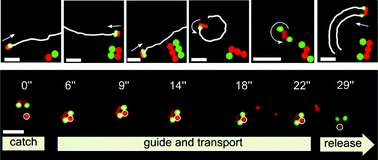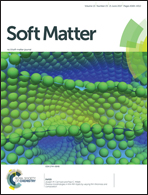Hybrid colloidal microswimmers through sequential capillary assembly†
Abstract
Active colloids, also known as artificial microswimmers, are self-propelled micro- and nanoparticles that convert uniform sources of fuel (e.g. chemical) or uniform external driving fields (e.g. magnetic or electric) into directed motion by virtue of asymmetry in their shape or composition. These materials are currently attracting enormous scientific attention as models for out-of-equilibrium systems and with the promise to be used as micro- and nanoscale devices. However, current fabrication of active colloids is limited in the choice of available materials, geometries, and modes of motion. Here, we use sequential capillarity-assisted particle assembly (sCAPA) to link microspheres of different materials into hybrid clusters of prescribed shapes (“colloidal molecules”) that can actively translate, circulate and rotate powered by asymmetric electro-hydrodynamic flows. We characterize the active motion of the clusters and highlight the range of parameters (composition and shape) that can be used to tune their trajectories. Further engineering provides active colloids that switch motion under external triggers or perform simple pick-up and transport tasks. By linking their design, realization and characterization, our findings enable and inspire both physicists and engineers to create customized active colloids to explore novel fundamental phenomena in active matter and to investigate materials and propulsion schemes that are compatible with future applications.

- This article is part of the themed collection: Soft Matter Lectureship Winners


 Please wait while we load your content...
Please wait while we load your content...